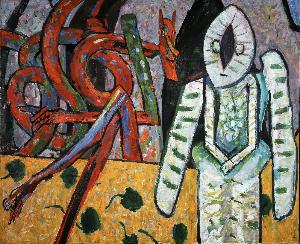Irving Kriesberg
Irving Kriesberg
Place: Chicago
Born: 1919
Death: 2009
Biography:
Irving Kriesberg was an American painter, sculptor, educator, author, and filmmaker, whose work combined elements of Abstract Expressionism with representational human, animal, and humanoid forms. Because Kriesberg blended formalist elements with figurative forms he is often considered to be a Figurative Expressionist.
Early Life and Education
Kriesberg was born on March 13, 1919, in Chicago, Illinois. He graduated from Von Steuben High School in 1937 and studied at the School of the Art Institute of Chicago, where he received his BFA in 1941. His teachers at the School of the Art Institute included the Russian-American avant-garde painter, Boris Anisfeld.
Career
Shortly after graduation from the School of the Art Institute of Chicago, Kriesberg traveled to Mexico City, where he lived and worked from 1941 until 1944. He studied graphic arts at the Escuela Nacional de Artes Plasticas, Mexico City and exhibited with Taller de Gráfica Popular. In 1945, Kriesberg moved to New York City and got a job animating signs in Times Square with Artkraft Strauss. Kriesberg befriended the Cubist sculptor, Jacques Lipchitz, who introduced Kriesberg's work to Curt Valentin. Valentin, a German-Jewish art dealer, ran an eponymous art gallery on 32 east 57th Street in Manhattan, which was known for exhibiting the work of established modern artists including Pablo Picasso, Alexander Calder, Max Beckmann, and Henry Moore. Kriesberg had his first solo exhibition at the Curt Valentin Gallery in 1955. Lipchitz wrote the introductory text for the exhibition catalogue.
Major Exhibitions
Some of Kriesberg's major exhibitions include:
- 15 Americans, a landmark group exhibition at the Museum of Modern Art, in 1952.
- A solo exhibition at the Jewish Museum in 1961.
- A solo exhibition at the Kumar Gallery in New Delhi, India, in 1966.
Kriesberg's work can be found on Wikioo.org, which features a collection of his paintings and sculptures. For more information about Kriesberg's life and work, visit his page on Wikipedia.
Artistic Style
Kriesberg's artistic style is characterized by the use of Abstract Expressionism with representational human, animal, and humanoid forms. His work often features bold colors and dynamic shapes, which create a sense of energy and movement. Some notable examples of Kriesberg's artwork include:
- Pastoral, a 1954 animated film with a musical score by Douglas Townsend.
- Out of Into, a 1972 avant-garde animation with an electric score by Bülent Arel.
Kriesberg's work is an excellent example of the Figurative Expressionist movement, which combines elements of formalism and representation. His use of bold colors and dynamic shapes creates a sense of energy and movement, making his artwork both visually striking and thought-provoking. For more information about Kriesberg's artwork and exhibitions, visit Wikioo.org, which features a collection of his paintings and sculptures.

